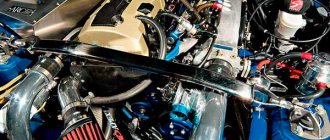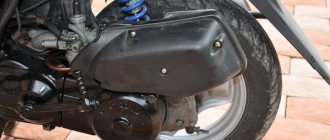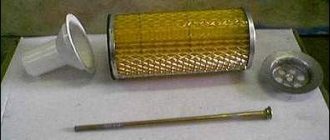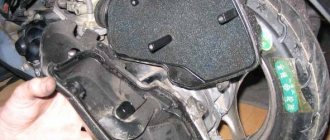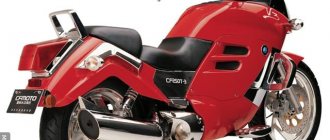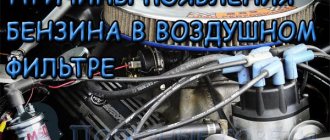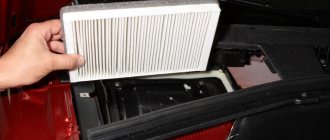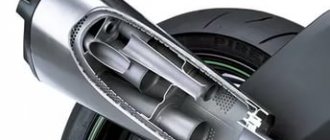Almost all car enthusiasts have a desire to increase the power and dynamics of their car. At the same time, everyone uses their own methods, based on capabilities and level of knowledge.
Some optimize the engine, others install various body kits and spoilers, others use high-quality consumables, and so on.
But experienced car owners know about another popular method - installing a zero-resistance filter.
So what is this device? What are the differences between “nulevik” and standard filters? Is there any point in spending money? Let's figure it out.
Introduction
For normal engine operation, it is necessary to create certain conditions, namely, a mixture of fuel and air prepared in the correct proportions, allowing for maximum efficient combustion to be achieved.
In this case, 15–20 parts of air are required for 1 part of fuel (depending on the engine configuration). When driving an ordinary passenger car with an engine capacity of 1.5 - 2.0 liters, 12 - 15 m3 of air will be required for every hundred kilometers. But the air coming from the atmosphere is saturated with road dust, insects, pollen and other debris. the air filter comes into play.
. Its functions:
- purification of incoming air by 99.9%, therefore, debris does not enter the engine;
- reducing the noise level coming through the intake tract;
- heat exchange during preparation of the fuel-air mixture (for gasoline engines).
Proportional to filter contamination
their resistance to intake air increases, which reduces their throughput.
Dirty air filter
What is zerovik?
An air filter is needed to clean the air and protect the engine from dust and other foreign objects entering the intake tract.
It’s just important to remember that the more intense the filtration occurs, the less powerful the engine becomes. Since most of the motor power is spent on air intake through the filter, elements made of paper offer strong resistance to air flow
After all, this part is made of dense material. It turns out that the stronger the air resistance in the filter, the more protected the engine is, while precious power is lost. This problem especially increases at the moment when the element becomes dirty.
For this purpose, a purifier with reduced open channel resistance is used. In this case, you can achieve excellent engine power by adding a “couple of horses” to it. Such a zero purifier helps reduce resistance to air intake without reducing its main tasks and even, on the contrary, increasing the capabilities of the engine. If the motor is intended for racing, this element has a place, but if the motor is standard, then is a zero gear needed?
- Is there any benefit from a nulevik air filter, comparison with a regular one?
Based on statistics, a nulevik increases engine power by an average of five percent. Outwardly, this is completely invisible, since less than five percent of horsepower is not felt at all, especially for a beginner.
Maintenance of zero vehicles
In principle, servicing tuning filters is no different from servicing standard ones. The filter element is cleaned by blowing air in the direction opposite to suction.
There are also types of filters that can be washed. It all depends on the material from which the zero is made. The possibility of washing is usually indicated by the manufacturer. It is necessary to make a reservation that most of the zeros are still disposable. It is impossible to completely wash out dust particles from a heavily soiled filter. Even after thorough purging or washing, its throughput will be lower than that of a new one.
For washable filters, maintenance boils down to rinsing it in water with a detergent solution and then drying it. The manufacturer specifies what exactly to use for washing.
For engines with insufficient power, such a filter is needed
How does a zero resistance filter element work?
Car enthusiasts love to give their car a variety of tuning, which may not necessarily concern the exterior design, but also affect certain characteristics of the engine itself. It is believed that it is possible to increase the power of the power unit by installing an air filter, which has zero resistance. There are completely opposite opinions regarding the effectiveness of this method, so it is necessary to take into account all the pros and cons so as not to make a mistake.
The principle of operation of such an element, which affects the power system (be it a carburetor or injector) and its operation, comes down to approximately the following. Air purification is carried out by the nulevik due to the adhesion of dirt particles, while the purified air enters the cylinders unhindered. But it cannot be said that this guarantees the separation of useless particles, and that absolutely all of them will linger on the body. Much will depend on the implementation of preventive measures to care for the zero car, but drivers usually forget to adhere to this.
How to change it correctly?
How to change the air filter on a Chinese moped? The sequence of actions for replacing the cleaning device in a moped is quite simple.
Instructions for DIY replacement steps:
First of all, we install the moped on the stand. It is also advisable to wash the moped to prevent dirt from getting into the moped components; Now you can start replacing: remove the protective cover of the battery; to do this, you need to unscrew one bolt with a Phillips screwdriver; Then we disconnect the battery from the terminals and take it out of the seat; Next, you need to remove the seat; to do this, you need to unscrew two bolts with a “10” key and move it with a sharp movement (from left to right in the direction of travel of the moped); As soon as the seat has moved, we lift it and it can be easily removed. Pull the clamp off the air filter pipe. If yours is not rubber, but metal, you must first loosen it; Now you can pull the pipe off the carburetor. This must be done carefully to prevent dirt from getting inside the carburetor; After the pipe has been disconnected from the carburetor, we pull it inward to the place where the battery was. The air filter housing is made of rubberized material, so it can only be deformed when removed, only carefully. Deforming the filter casing, carefully pull it
This should be done extremely carefully, as you can touch and break the wires passing nearby; After successfully removing the casing, remove the filter from it. If there is dust or dirt in the casing, it is necessary to wash and dry it; Now install the filter and reassemble in reverse order
Before installing the seat and battery cover, make sure you have not cut or disconnected any wires during installation.
Is a zero-resistance filter any good? Installation and maintenance.
This post has 2 comments.
A standard air filter in a car cleans the air from dust thanks to paper pressed into several layers. It does an excellent job of providing the engine with the required amount of air and, thereby, providing its power - but only while it is new. The fact is that small pores in the paper, which allow air to pass through and trap particles of dust and dirt, become clogged over time and block air access to the engine. A vortex effect occurs, due to which dirt particles penetrate deeper into the filter, completely clogging it. As a result of decreased air supply, it falls.
Of course, any standard “air” allows less air to pass through after contamination, but that’s not the only problem. Holes - pores in the paper are located in a chaotic manner, so the air experiences additional resistance as it moves through the layers of a standard filter (vacuum cleaner effect). At the same time, a zero-resistance filter containing a cotton filter element is designed in such a way that it does not create vortex effects and dirt and dust particles do not penetrate into its structure, remaining outside.
When installed in a standard socket, or (much better) without a standard housing for the air intake system, the “nulevik” cleans the incoming air over its entire surface, allowing more air to pass through than the standard one. Cotton is an excellent material of organic origin, so the zero-resistance filter is not affected by moisture and temperatures. If it gets wet, it will take a minimum of time to dry and it will be back to work. The use of such a filter will increase engine power by 5%.
Pros of a zero resistance filter:
- — adds up to 5% power.
- - reduces fuel consumption.
- - changes the sound of the engine.
- — makes the engine compartment look more sporty.
- - Possibility of standard installation.
Disadvantages of "nulevik":
- - requires regular maintenance (every 2000-3000 cleaning and impregnation).
- - a cheap filter contributes to oil contamination and engine wear.
- — a high-quality brand filter is expensive.
- — after installing a separate filter, a decrease in power may be observed.
Installing a zero resistance filter
“Nulevik” can be installed in a regular place or separately. Individual zero-resistance filters add drama to the engine compartment and are considered the most productive. But a separately installed filter sucks hot air heated by the engine, and the heated air has a lower density and it turns out that the engine loses power because it “breathes” hot air.
Air filter for VAZ 2114
The standard square “zero” captures cold air from under the bottom of the engine and next to the wing, and cold air has a higher density, due to which there is a 5% increase in power. Branded versions of zero-resistance filters cost up to several thousand rubles, but you can save significantly if you modify an already installed air filter: cut off a piece of the housing (bottom) of the air filter, which will provide a greater flow of air into the combustion chamber.
Impregnation for zero resistance filter:
- — remove the filter and treat both sides with a special spray intended for washing.
- - Allow time for the dirt to dissolve and drain, then rinse the filter under running water.
- — let the filter dry, this will take up to 10 hours (you cannot speed up drying with a hairdryer, over a radiator, etc.).
- — apply special oil to the filter (included with the cleaning spray); a properly soaked filter should acquire a red tint (after washing it will turn gray).
- — install the “zero” in place.
Is it possible to install a zero resistance filter on a scooter or moped?
Installing a “nulevik” on a scooter or moped is justified only if you plan to use the same scooter/moped in racing. If you install a cheap Chinese analogue of the “nulevik”, the scooter will become noisier when riding and the wear of the CPG will accelerate. Installing an expensive “nulevik” on a factory engine will not make the scooter/moped more powerful and faster, since you will have to reconfigure the carburetor, but the factory settings cannot always be combined with homemade tuning.
MAF – mass air flow sensor.
Sports front seats.
How to choose a car DVR.
Installation Features
Many car enthusiasts make a big mistake - they install the “zero” incorrectly, which is why it is not able to perform its functions normally.
For example, the filter is installed too close to a hot engine or exhaust manifold. Here it’s time to remember physics.
The density of cold air is higher than that of hot air. As a result, it is easier to “push” cold air into the combustion chamber than hot air.
Therefore, the “nulevik” should be located as far as possible from any heat sources (motor, exhaust manifold, etc.).
In addition, it is not recommended to install the filter in the lower part of the engine compartment. In such a situation, the product will quickly become dirty and lose its best qualities.
In addition, a dirty filter will have to be “repaired”, which will also take some time.
Today there are a lot of models of zero filters that are designed for installation on various types of cars - with an injector or a carburetor.
The material can be mesh, foam rubber or cotton. Filters made of foam rubber have the highest degree of purification, but they also have more resistance than their “brothers”.
Installation of the “nulevik” on different cars is done differently, but in general you need to follow the following algorithm:
- discard the connector from the MAF (mass fuel flow sensor);
- use a screwdriver to disconnect the rubber tube from the air flow sensor;
- remove the sensor fasteners from the body (to do this you will have to unscrew a couple of bolts);
- dismantle the case and remove the rubber clamps (use duckbills or pliers);
- unscrew the fastener from the group of wires;
- fasten a pair of bolts from the mass air flow sensor clamp to the “zero” fastener;
- Place a new filter on the mass air flow sensor, tighten the clamping clamp and connect the sensor.
That's all, the new filter is installed on the car.
Pros and cons of a zero resistance filter
As we wrote above, such filters have their advantages and disadvantages. Among the advantages are:
- Increase in engine power (about 5-7%)
- More efficient combustion of fuel in the cylinders
- The result is reduced fuel consumption
- Spectacular appearance
Among the disadvantages, there are 4 reasons why you do not need such a filter:
- Reduced engine life
- Difficulty of operation
- Wear of the air flow sensor
- High price
More about the disadvantages. Engine life is reduced due to an increase in dust particles (and even sand) that can get into the internal combustion engine cylinders. The particles are an abrasive and not only erase the stains on the walls of the cylinder block, but also clog the oil scraper rings.
How to change the air filter
The difficulty of operation lies in the much shorter service life of such a filter, as well as the need for regular cleaning and impregnation of “wet” filters. Dry filters also quickly become clogged with dust and oil and require timely maintenance or replacement.
The mass air flow sensor (or flow meter) also suffers from dust and sand particles that enter through the filter and clog its contacts. In general, it is quite easy to clean, but the abrasive effect will not go away.
And finally, another good reason to abandon such filters is their price. The cost of original, good quality products starts at 4,000 rubles, while a regular, original filter can be bought for 600-800 rubles.
Advantages and disadvantages of “nuleviks”
As practice shows, such filters have their positive and negative qualities.
Let's start with the pros:
- increase in power by 5-7%. Of course, this may not be noticeable to the driver, but when installed in combination with other types of engine tuning, the result can be felt for yourself;
- changing the sound characteristics of the motor. It is believed that the filter element makes a special sound, which changes the general hum from the engine compartment. Many car enthusiasts install “nuleviks” precisely for this reason;
- The appearance of the space under the hood changes - it becomes more sporty.
Disadvantages of "nulevik":
- the need for constant maintenance, which not all car owners like to do;
- affordable filters are of low quality, so they clog almost immediately. The oil also becomes contaminated faster, which leads to a decrease in the life of the power unit.
Cold intake/inlet pipes (9)
The purpose of the standard intake filter of a VAZ car and other cars is to supply atmospheric air purified from impurities and mechanical particles into the engine combustion chamber.
But despite the fact that the standard filter performs its task well, due to its dense structure it makes it difficult for a certain amount of air to enter the combustion chamber, which in turn does not allow increasing the amount of the fuel-air mixture and thereby increasing the pressure on the piston (which We ultimately achieve an increase in power). To reduce these losses, a so-called zero-resistance filter (ZRF) was created.
This section presents low (zero) resistance filters, which are designed to increase the throughput of the entire vehicle intake.
An increase in throughput leads to an increase in the amount of air in the air-fuel mixture, and accordingly, with more air, the combustion process is more efficient, which increases engine power.
Carburetor filters differ in that their mounting points are designed to be installed on top of the carburetor, while injection filters have an inlet for docking with the inlet pipe.
What are the advantages of this filter over the standard one? read more >>
PERFORMANCE WHEN INSTALLING A ZERO RESISTANCE FILTERLow resistance air filters are one of the favorite topics of discussion among tuners.
The part is available, easy to install, there are countless options, and... the view is beautiful (also important!). But the debate about the benefits of “nuleviks” does not stop
Shall we figure it out? Here are the results of professional tests......Some people foam at the mouth to prove the usefulness of the filter and say that before installation the car “didn’t move”, but after that “it went soooooooooooooooooooooooooooooooooooooooooooooooooooooooooooooooooooooooooooooooooooooooooooooooooooooooooooooooooooooooooooooooooo!” believing that there can be no benefit from the “nulevik” except harm, and still others don’t know what to think. What is it really like?
Tuning specialists tested several low-resistance filters. Testing was carried out on a Bosch power stand. For the purity of the experiment and objectivity, two measurements were taken with each filter. However, there was not much difference, so in the table we indicated the results of only the first attempts. The rated power of a VAZ-21103 car with a 16-valve engine of 1500 cubic meters was taken as the standard. see. All filters were placed under the hood of this particular “ten”. The car's equipment is standard, mileage is 10,500 km. We took four measurements with the factory filter. The average result is 71.6 kW (or 94.11 hp) at 5320 rpm.
As for the other experimental filters, we can immediately report: the results were close to expected. Yes, in most cases, low-resistance filters provide a power increase of about 6-9%.
With the purchase of a “sports” filter, the car enthusiast is required to regularly (every 10,000 km) wash and impregnate the filter element with a special solution (and withstand a certain technology). You cannot forget about periodic maintenance of the filter, otherwise the machine will become “dumb” and “gluttonous”.
Low-resistance filters, which are installed in standard boxes (“panel”), are invisible and therefore less popular. Can you really brag about it to your friends - “Look what you put in!”...
One more misconception. It is believed that if you remove the filter and its housing altogether, the engine power will increase, and significantly. This is wrong. Our measurements confirm this. The fact is that engineers calculate valve timing taking into account filter losses. And from a practical point of view, an engine that gets into abrasive (dust) will not last long.
Most of the filters in this test are universal cone type. This form is not a tribute to aesthetics, it is optimal from a practical point of view. A pair of “cones” - with an internal diffuser. As measurements show, this design gives the best performance.
—————Data from the Federal Tax Service Comparison Table————–Measurement, maximum power obtained, kW/hp. Power change, % from the original value, Brand, model, filter type (filters 2-7 are installed with an additional bracket)1 Increase from 69.2 to 94.11 hp Standard VAZ Power change, % from the original value +6.45
Why is this necessary?
First, let's figure out what it is and what it is eaten with. A standard or regular air filter is designed to clean the air entering the engine from all kinds of contaminants. It is due to air filtration that power loss occurs.
This is due to the fact that the cleaning elements in the filter design (usually special paper) create resistance to air flow. This is not surprising since the filtration material is very dense. And the higher the resistance, the more the final power is lost. As you know, increasing power is achieved by increasing the amount of incoming air. This is where the zero impedance filter comes into play.
Nulevik is an alternative to the standard cleaner. Its design is such that the device reduces intake resistance without sacrificing air purification itself. This results in an increase in power.
And here a logical question arises: is your Priora, VAZ 2112 or VAZ 2114 worthy of such an element? Is it even worth buying a zero car if you want to slightly increase engine power?
Practice and research show that such a small tuning as installing a zero level allows you to get an increase of 3-5% in power. If this is a low-power car, then you definitely won’t feel an increase of several horsepower. You also won't see any difference in dynamics. But the numbers will be higher than you can comfort yourself a little.
Key Benefits
Reading reviews about nuleviks, I came across many conflicting opinions. One installed such a filter on his injector and was very pleased. Another spent a lot of money on a K&N zero and its installation, wanted changes, but in the end all he got was wasted time. And there are many such examples.
I’ll say right away that ordering zero-resistance filters from auto stores is not a problem at all. The price for some models is quite reasonable, so it is not difficult to buy and is relatively inexpensive. But whether such an element needs to be installed on a VAZ with your own hands is an extremely interesting question.
Let's start with the good. Like any device, the Nulevik has its pros and cons. The disadvantages include the cost compared to a conventional air filter and the need for constant cleaning.
As for the advantages, there are several of them.
- Power increases. The nulevik has a complex design that allows it to reduce resistance. This gives an increase in horsepower;
- Simultaneous cleaning efficiency. Although the resistance drops, this does not affect the quality of air purification;
- Replacement frequency. There is no need to change the nulevik as often as a regular filter. They are washable. This allows you to return full performance characteristics;
- Increase in characteristics. Albeit a little, but the zero gear adds power and increases torque;
- Sound. For many, it is not the power that is important, but the sound characteristic of powerful engines. Nulevik creates such an effect, and as a result the car sounds very interesting.
To achieve what you want, you will have to remove the standard filter and install a zero-resistance device in its place. Decide for yourself which is better, buy and install it yourself, or give the car to the experts. In the second case, there will be a guarantee of quality and a well-chosen filter. The main thing is that the specialists themselves are qualified and reliable.
How to make a zero filter with your own hands?
Some car enthusiasts, in a desire to save money, decide to make a “nulevik” with their own hands.
The source is a factory round filter, which was once installed on Moskvich cars.
To make a “nulevik” you can use different methods. We will describe one of them below.
You will need available tools (foam rubber, sealant, sharp knife, glue and others). The total price of the issue is no more than 3-4 US dollars.
It’s worth noting right away that a converted “zero” is unlikely to add power to your car. The reason is outdated technologies that were used in the production of cars in the 70-80s.
When creating filters, manufacturers thought little about the importance of cleaning, so old products only retain very large pieces of dirt. So, by “creating” a zero filter, you are taking a certain risk and can “kill” your engine.
By the way, the only car where such a zero filter would be “at home” is the Moskvich. At the same time, there are owners who immediately cut off the walls to eliminate excess flow resistance.
If you decide to experiment, the sequence will be as follows:
- remove the standard device;
- Make a rectangular adapter with a hole from a piece of plywood.
Drill four more holes and fix the adapter to the air meter sensor.
Before doing this, install a piece of pipe into the hole and treat the cracks with sealant;
- Make additional holes in two plywood circles. At the same time, make a hole of a larger diameter on the outer circle, and on the inner circle (installed near the air meter) - according to the diameter of the pipe being installed. The latter shrinks using sealant;
- make 3 bars with a length of about 16-18 centimeters and use them to fasten the circles. The result will be a unique cylindrical shape. Since there is no plywood in the bars, it is necessary to make holes along the edges for installing self-tapping screws (otherwise the plywood may be damaged);
- To prevent the foam from falling out, make a body. To make it, you can take a mesh for GVL joints. The advantage is the presence of a sticky base, which allows for immediate fixation;
- then foam rubber is glued on the outside using thermosealant, which allows you to securely and quickly fix the device;
- fix a couple of pieces of foam rubber for the side of the barrel with sealant;
- put on foam rubber and fasten the plywood beams with ties.
There are simpler solutions.
An important component that can extend the service life of the engine
This is a theory. Practice says that the engines of modern cars have such a component, a part, as an air filter. Through which the air passes to form a combustible mixture in the engine. The air passing through the filter is cleaned of dust and abrasive particles. However, like any medal, this one also has a downside. And it lies in the fact that an ordinary, standard paper filter becomes an obstacle to the air flow. This leads to a drop in engine power. Not so much that it is very noticeable, but to a certain extent such a decline is present.
Relevant, first of all, for sports and forced engines.
For standard engines, such a drop is not only not scary. It may even be imperceptible. However, if, say, a car enthusiast spent money on tuning the engine of his car, preferring a sporty style and driving style, then in this case, as they say, every “horse” counts. And then the resistance of the standard air filter becomes a serious obstacle.
Installing a zero resistance filter
You can install a “zero filter” on any car, since currently not only “zero” filters are produced that are mounted in standard places on specific car models, but also universal products that can be installed using a special adapter, which is often included in the kit. for different types of engines, regardless of the design of the standard mount.
You can carry out the installation yourself, without involving service station workers. The procedure is extremely simple and takes just a few minutes. All you need to do is remove the standard filter element and install a new one. In the case when a universal filter is installed, it is additionally necessary to dismantle the factory housing, which also will not create any problems.
It should be noted that during installation it is very important to ensure the tightness of the pipes in order to completely eliminate the possibility of dirty air entering the engine path
Also, special attention should be paid to the location of the filter. If a conical sports filter with a flexible pipe is installed, then it must be secured as far as possible from the radiator so as not to spoil the parameters of the inlet air
How to care for such filters?
As already mentioned, one of the main disadvantages of the filter is the need for regular maintenance.
After purchasing and installing the product, it must be washed and treated regularly. In this case, processing according to the “remove-wash-install” principle will no longer work - a special algorithm is required here.
The frequency of washing is every 5-6 thousand kilometers. If the car is operated in dusty areas or off-road, then the filter must be cleaned more often.
If you forget about servicing the device, the machine becomes “gluttonous” and “dumb.”
The algorithm of actions is as follows:
- remove the zero filter from the machine and remove all dust from it using a special brush;
- Wash the unit in a special container with a special cleaning solution, then rinse the filter under water pressure;
- shake off the filter element and inspect it. If there are light spots, the filter needs to be impregnated with a special agent;
- treat the product with a special impregnation (as a rule, it is sold separately from the “nulevik”);
- return the “zero” to its original place.
There are even special kits for caring for “nuleviks”, which include washing and impregnation. A few manipulations as described above, and the product looks like new.
Please note that the total number of washes can be limited and is about 20 pieces. After this, it is worth installing a new filter.
Signs that it's time to change your air filter
You should replace the filter element if you notice the following symptoms:
- popping noises appeared in the exhaust system;
- the engine began to run unevenly, the speed was jumping;
- fuel consumption has increased or decreased significantly;
- acceleration dynamics decreased, the car became “wobbly”;
- there were problems starting the engine (misfire, longer starter operation);
- cooling turns on more often;
- the quality of engine operation changes in wet weather (due to changes in filter density upon contact with moisture).
Waste air filter
The frequency of filter replacement for some car manufacturers can reach 60,000 km. But this is very rare, and, of course, it is better not to wait for such a period
It is important to remember that using a dirty filter not only significantly reduces engine life, but also shortens the life of injectors, spark plugs, fuel pumps, sensors and other parts.
What are the advantages of a zero filter?
Let's look at the advantages of the nulevik:
- The main positive point is considered to be an increase in engine efficiency when using a filter with minimal resistance. Owners also note a decrease in fuel consumption.
- There is no need to change this part every ten thousand kilometers, since it is easy to remove, wash and put back. The filter completely returns all its original properties.
- When you install the nulevik, your engine will start with a different sound. You will also add a few horses. In addition, torque at medium and low speeds will increase.
As you can see, there are advantages, although they are few.
To do this, you should assemble it together with a liner that is designed to filter air masses. Next, a sensor is installed that takes into account the mass air flow. You can select the diameter of the filter only by knowing the dimensions of its seat. This way you will set the zero level, after which your stallion will have new strength.
Why do you need an air filter?
Absolute zero only occurs in space, and then only for a short time, and then it depends on where you’re counting from. And if the filter has no resistance, then what kind of filter is it then... But first things first. An air filter is necessary for any internal combustion engine, any compressor, in a word, any mechanism that consumes air. Especially in large quantities, especially in difficult temperature conditions. Of course, we are getting at the fact that a car engine, like no other mechanism, operates under extremely difficult and often unexpected conditions. It consumes a huge amount of air with a high content of solid silicon particles, which housewives call dust.
The Germans from the Sachs laboratory estimated that for every 100 European kilometers of the autobahn, a car swallows 60 grams of pure dust. Please think about this terrible figure. We take a stack of grated silicon, pour it into the intake manifold and start the engine. You get shivers down your spine when you think about how much dust our VAZ 2107 eats up, meandering around the Vologda region for 400 kilometers. Yes, some of the dust settles on the walls of the manifold, throttle body or in the labyrinths of the carburetor, but sooner or later it will get to the cylinder-piston group , will get into the oil and begin to eat the rubbing surfaces. In short, an air filter is necessary.
But there is a point
There is a common misconception that by removing the filter and housing you can significantly increase engine power. This is completely untrue.
It is important to take into account that when developing an engine, a careful calculation of the valve timing is made, which takes into account errors and losses on the filter. And if dust starts to enter the engine, it will definitely not be able to work for a long time. Here it is necessary to have a fence that will prevent the penetration of contaminants
Resistance can be reduced by widening the passage holes. But then the quality of filtration will decrease
Here it is necessary to have a fence that will prevent the penetration of contaminants. Resistance can be reduced by widening the passage holes. But then the quality of filtration will decrease.
Before looking for a product code and buying a zero for your motorcycle or car, remember one simple truth. For cars without a powerful sports engine, the cost of purchasing such a filter will be absolutely pointless. You will only waste several thousand rubles. The only thing you will get is a slightly changed engine sound.
Nuleviks are only suitable for sports cars and cars with powerful power plants. The use of such a filter on serial engines is allowed only in cases where a comprehensive modification is carried out. That is, boring is done in the cylinders, an enlarged throttle valve is mounted, sports camshafts are installed, etc. You can also put a zero in the kit with them.
Reviews
The best indicator of the need to install such a device is reviews from real car enthusiasts. Here are some of them:
Anton, Belgorod.
“I’ve been driving with a zero car for a long time. I did the intake and exhaust at the same time, so the result was significant (like after a good engine chipping). If you install a zero filter on a regular car with normal settings, there will be no result.”
Egor, Kazan.
“I didn’t feel any effect from installing a zero filter. What can be changed by installing a piece of rag?!”
Mikhail, Smolensk.
“When you turn off the engine, there is a unique suction sound that adds to the “sportiness” of the car. I installed a “zero” on the Galant and am pleased. The car felt faster.”
Why is the regular one so bad?
Again, everything is simple - as you and I know, an internal combustion unit has only 4 strokes, these are intake, compression, ignition, and exhaust gases. The engine, on the intake stroke, sucks the air-fuel mixture into the engine cylinders; if gasoline flows through its own line, then air is sucked in from the environment. If there were no filter, it would be sucked in with everything that came across (midges, dust, etc.), but the filter protects against this - however, it is a kind of plug that prevents the air from passing through normally, that is, resistance is encountered.
The standard filter element has a significant resistance coefficient, often taking away 5 - 7% from the engine power. This is understandable, it practically does not allow dust particles to pass through, and is made of special paper.
This element is far from ideal, it seems like everything is simple, but damn there is no solution and that’s it! Or is there?
Pros and cons of installing in a regular place
But there are many more disadvantages:
- Hidden installation of the filter under the housings prevents full access of air to the filter. For zero engines this is especially critical, because their purpose is lost - to give the engine as much air as possible.
- In addition, installing the filter under the housing requires the use of an air duct, which is a flexible rubber pipe that runs from the filter to the intake manifold, which integrates the intake, carburetor and cylinder.
- Due to the design features, the air duct most often has a curved shape, so the air flow in it changes direction. Passing through such a pipe also creates resistance to flow. To improve performance, a direct-flow filter for the carburetor is best suited. This type of zero does not require an air duct, has open access to ambient air and is the most efficient.
Why is the regular one so bad?
Again, everything is simple - as you and I know, an internal combustion unit has only 4 strokes, these are intake, compression, ignition, and exhaust gases. The engine, on the intake stroke, sucks the air-fuel mixture into the engine cylinders; if gasoline flows through its own line, then air is sucked in from the environment. If there were no filter, it would be sucked in with everything that came across (midges, dust, etc.), but the filter protects against this - however, it is a kind of plug that prevents the air from passing through normally, that is, resistance is encountered.
The standard filter element has a significant resistance coefficient, often taking away 5 - 7% from the engine power. This is understandable, it practically does not allow dust particles to pass through, and is made of special paper.
This element is far from ideal, it seems like everything is simple, but damn there is no solution and that’s it! Or is there?
How is it different from other types of filters?
The main difference between the “nulevik” lies in its design. Classic filters installed on most cars are made of paper (more precisely, from compressed fibers).
The flow of air masses passes through small holes in the fibers, and then goes to the motor.
As soon as the fibers become clogged, the resistance also increases, because the air needs to find new ways to overcome the obstacle. If you do nothing, the engine power drops.
Taking into account existing standards, the paper filter must have a large thickness with maximum fiber compression. This design ensures high-quality cleaning, but the resistance is increased immediately after installation.
The design of the “nulevik” is based on the principle of reducing resistance.
The device is based on several layers of cotton, which effectively traps dust and dirt. In this case, the retained particles essentially become part of the product.
Thanks to this, the efficiency of the filter element is higher and one square centimeter of surface accepts more dust than its predecessor.
Cotton fabric is sandwiched in an aluminum screen, which increases the filter surface. The developers claim that the working part of the “nulevik” is 4-5 times larger than in a classic filter, which ensures a long service life and lower resistance of the product.
This is achieved thanks to another factor - the presence of a special coating (oil) on the cotton, which traps dirt without harming the flow.
The principle of operation of the filter, its features
The operating principle of the “nulevik” is based on two factors:
- high-quality cleaning of the flow entering the motor;
- minimum air resistance.
The effectiveness of the zero resistance filter is due to its unique design and the use of cotton (rather than paper) material.
The incoming flow is filtered from dust without causing any significant contamination to the product. Thanks to special impregnation, particles entering through the filter settle on the surface and do not interfere with the flow of air to the combustion chamber.
As a result, a sufficient volume of air enters the intake manifold, and the power of the power unit increases.
PROS AND CONS: IS THERE A SENSE OF “ZERO”?
In reality, the difference with and without a filter is noticed only on a dynamometer stand. The benefit of reducing the resistance of only one element of the intake system appears exclusively in the “full throttle” mode at high speeds; in the standard city driving cycle, the effect of the “zero filter” is exactly zero.
Even for forced engines, reducing intake resistance gives a penny of benefit. Let's take for example a graph taken on a dyno with a Nissan Skyline ECR33, whose RB25DET engine has already moved away from the standard configuration:
The result is not bad - 250 horsepower at the wheels. But, if we remove the air filter altogether - to ensure a reduction in intake resistance even greater than that of a high-quality "zero" - we will get the second graph:
The drop in power after the 5000 rpm peak has become smoother, but the difference in numbers is negligible: its increase without a filter is only 8 horsepower. With 250 hp, which is already there, it is impossible to notice anywhere except on the track, when hundredths of a second count.
And you have to pay for these pennies by complicating maintenance and deteriorating air purification.
In addition, the oil impregnation of “zero” vehicles itself can cause problems on engines equipped with mass fuel flow sensors. The air flow, passing through the filter, carries along microparticles of oil, which then settle on the walls of the inlet pipes and directly on the surface of the sensing element of the mass air flow sensor. Because of this layer, which acts as a heat insulator, the mass air flow sensor begins to “lie”, giving an incorrect signal to the injection computer. And here, based on the “outdated” composition of the air-fuel mixture, the conversation will not be about a microscopic increase in peak power, but about a noticeable drop.
In some cases, the installation of the Federal Tax Service itself can even reduce the maximum engine power. When installing a fashionable cotton “cone” or a foam “mushroom”, you have to dismantle the standard air filter box and air intake. If the layout of the engine compartment is unsuccessful, after this “anti-tuning” the engine does not receive air that is close to atmospheric temperature, but air that is already heated, passing through the radiator. An increase in air temperature for every 10 degrees Celsius gives a loss in density of 0.04 kg/m3 - and an average atmospheric two-liter engine, revved up to 5000 rpm, drives 35 - 40 cubic meters through itself per minute! As a result, an engine with a zero-resistance air filter receives less air mass than with a standard, supposedly “stifled” intake.
An inevitable harm from using zero air filters is accelerated wear of the cylinder-piston group. Even the air purification results of these filters declared by the world's leading manufacturers (for example, K&N) do not exceed 99% under ideal conditions and using expensive branded impregnation oil. The paper curtain air filter is capable of filtering out 99.5 to 99.9 percent of dust. It would seem that the difference is small - but after several tens of thousands of kilometers we will already be talking about the difference in whole grams of dust that gets into the engine cylinders. Moreover, as the paper filter gets dirty, it only increases the degree of filtration: dust, clogging the pores, reduces the flow area, and they become capable of trapping smaller particles, although at the cost of increasing resistance.
In “zero” filters, contamination on the surface of the pores reduces the likelihood of new particles adhering, and the cross section of the pores remains larger than the size of the filtered particles; as contamination increases, the degree of purification decreases with little change in resistance. Previously used contact-oil air filters suffered from the same thing, where oil soaked the fishing line stuffed inside (designs familiar, for example, from old Soviet trucks and motorcycles). “Nuleviks” have become a more compact and lighter version of these filters, which have long been replaced by paper filters.
And errors during filter maintenance only increase the wear rate. Some people manage not to saturate the filters, while others use cheap aerosols or oils that are completely unsuitable for impregnation. Try rubbing a drop of the brand's impregnation oil between your fingers: it's so sticky that it's hard to even wipe it off your fingers. Other oil will not provide any noticeable improvement in cleaning compared to a filter that is not impregnated at all.
The only advantage for engines that have not undergone serious tuning from installing “nuleviks” can be considered the absence of the need for regular replacement: you need to wash and re-impregnate the same filter on time.
Types of “nuleviks”
Zero filters use cotton fabric as a filter element, which is softer in structure than cellulose and does not provide high resistance to air suction. The screen canvas is folded like an accordion, which increases the filtration area.
To increase the effect, manufacturers use special impregnation of the filter screen. A viscous medium is better at trapping the smallest dust particles. Today manufacturers offer two design options:
- dry;
- with impregnation (“wet”).
The location of the filter is not in the normal place. Filter material in a dry design reduces motor power by 1-1.5%. The impregnated filter provides almost zero resistance and returns lost 5-7% of power to the engine. The cotton screen is impregnated with a special composition, which must be renewed every 2,000 - 3,000 km.
